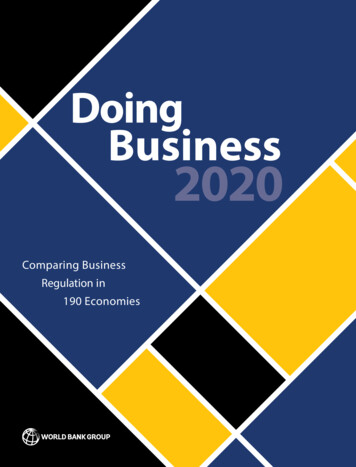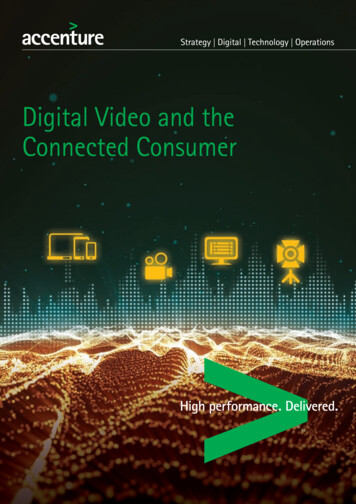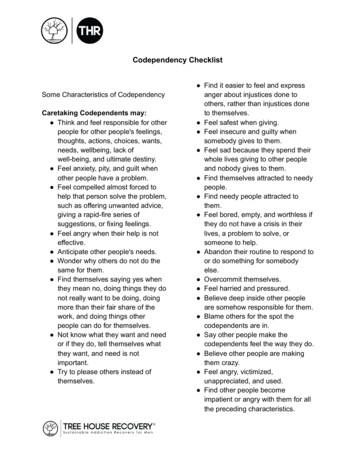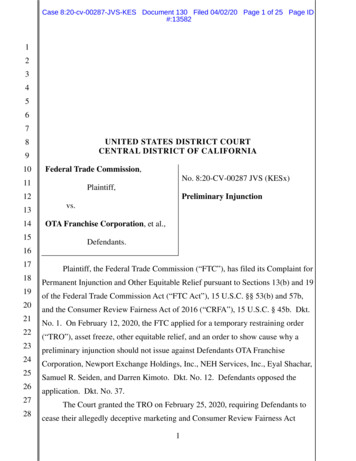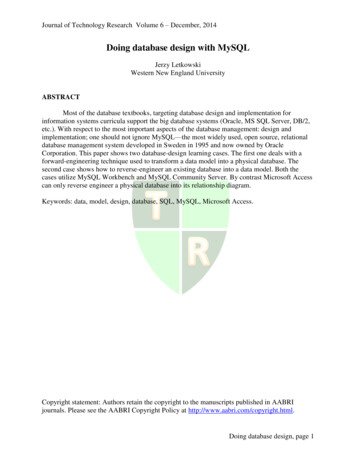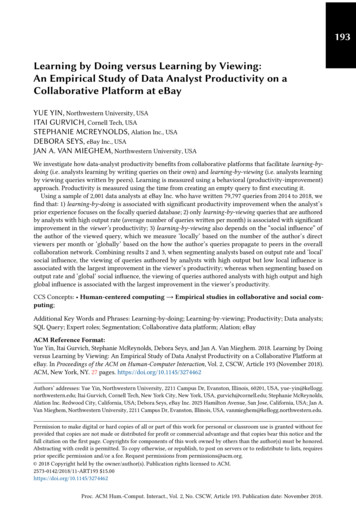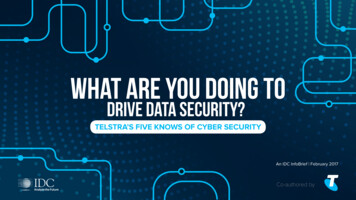
Transcription
What are you doing todrive data SECURITY?TELSTRA’S FIVE KNOWS OF CYBER SECURITYAn IDC InfoBrief February 2017Co-authored by
Executive SummaryInformation Is An Asset – Manage It CarefullyDigital transformation (DX) is sweeping the workplace as organisations realign themselves totake full advantage of the digital economy. At the heart of this transformation is the informationthat organisations create, capture, store and analyse in order to be more efficient, effectiveand competitive in a data-driven world.However, organisations are often challenged to have a method to value data in order tounderstand what matters and how it should be protected — both on- and off-premises.To that end, global technology provider Telstra developed a security methodology for itsinternal use and is now extending it to other enterprises seeking to protect their networksand data. Telstra’s five knows of cyber security addresses the key data management andsecurity issues facing enterprises today.This IDC Infobrief takes a closer look at how business leaders can apply this framework, incorporate itinto their risk management processes, better understand how to protect the valuable data across theirorganisation against the onslaught of cyber threats, and manage the risk that digital transformation amplifies.Armed with this tool, critical advice and practical guidance from Telstra’s own implementation, organisationscan embark on their data security program with confidence that it will provide a higher level of riskmanagement around their data assets.
Know The Value Of Your DataYou need to know what value it has, not just for your organisation and customers but also the valueto those who may wish to steal or change it.What is the value of your data?Self-discovery questions include:Are you aware thatdifferent data typeshave different valueto the organisationand to threatactors?Use these tips from the field as a starting point:Empower the business to better manage informationsecurity risk using Telstra’s five knows of cyber securitywhich defines the topic in terms that business users canunderstand and relate to.ZIPDo you understandthat data does not onlyhave an internal valueand that most dataalso has value on theblack market?How do you establish the value?Have you considered the costlyeffects of data loss: financialpenalties, negative publicity,brand damage, leakage ofconfidential information tocompetitors, loss of competitiveadvantage, and becomingvulnerable to cyber crime?Identify a working group across the organisation to get thebusiness to take greater ownership of the issue.Identify the value of the asset so as to define how well itneeds protecting.Focus on the most critical first, and build from there.No organisation is immune to potential data theft or loss.
Know Who Has Access To Your DataYou need to know who has access both within your organisation and externally, like who has“super user” admin rights in your organisation and amongst your trusted partners and vendors.Who has access to your data?Self-discovery questions include:How do you know who you can trust?Use these tips from the field as a starting point:Does your organisation review or revalidate access to dataas staff move around the organisation (providing staff withaccess to sensitive data that is not required to do their jobscan significantly increase your risk exposure in the event ofa breach)?Who (or what, e.g.,printers, camerasor other networkdevices) has accessto what data?Have you consideredwho has access toyour data when it isshared with serviceproviders and storedin the cloud?Do you include serviceand cloud providers,contractors, fourthparties (your vendors’third parties) as well asoperational technology inyour security monitoring“watchlist”?Also consider those outside your organisation who may haveaccess to your data — don’t just look internally.Ensure key service providers who have access to your datahave undergone your security evaluation.Continuously evaluate your data — the review process is notjust a one-time effort.Your organisation is responsible for your data, regardless of who is managing it.
Know Where Your Data IsYou need to know where your data is stored. Is it with a service provider?Have they provided your data to other third parties? Is it onshore, off-shore or in a cloud?Where is data stored?Self-discovery questions include:As part of the holistic approach to combatingcyber security, have you ensured that this processencompasses all data, regardless it ison- or off-premises?How to know where your data is located?Use these tips from the field as a starting point:Decide if certain data needs to remain onsite, and ifso, why.Empower the security team to assess current and newshortlisted service providers, and to create a risk profile.Is data located in places it should not be?Is your organisation equipped to know the differencebetween a hack and normal user behavior?Are you including cloud and offsite vaulting in the overallprocess, as well as breach notification?Contract with providers to ensure the policies of yourorganisation are met by these partnerships.Begin with what you control, establish the baseline, and thenshare the expectation across your ecosystem.Focus on the data, and where it is actually located, and less onthe systems and where you “believe” it to be located.Trust levels and security posture can change, so the reviewprocess is not just a one-time effort.Data can be in a variety of locations, both static and mobile, and notalways where you expect it to be.
Know Who Is Protecting Your DataYou need to know who is protecting your valuable data. What operational security processes are in place?Where are they? Can you contact them if you need to?What is your data management process?Self-discovery questions include:Does your own team understand and adhere to the designatedprocess for data security and management?Do your suppliers, partners and contractors also comply?How do you evaluate to show they know the process?How do you audit them?Many hacks and breaches are as a result of an insider. Whatare you doing to monitor and measure this?How to protect your data?Use these tips from the field as a starting point:If sensitive data is being stored on “shadow IT” systems, whois protecting it? Would your organisation know if it was lost orstolen?Ensure your policy can be implemented across the manydevices and systems where this data may be stored.Ensure your business ecosystem of suppliers and partnersunderstand how you value data, and encourage them to adopta similar stance.Be sure you know what data is being managed by third parties,and they understand your values and principles of dataintegrity.Strong data management has inherent business value,tie this process back to the business stakeholders.
Know How Well Your Data Is ProtectedYou need to know what your security professionals are doing to protect your data 24/7. Is your data being adequatelyprotected by your employees, business partners and third party vendors who have access to it?What is a strong risk managementprocess?Self-discovery questions include:How do you achieve this?Use these tips from the field as a starting point:Understand that this is about “business risk”.Don’t expect IT to be mind readers; it’s your data, and youshould value it accordingly.Do you have asystematic securitymethodology (likeTelstra’s five knowsof cyber security)to embed intoyour overall riskassessment process?Do you have the rightpeople, processes andtechnology in place?There is no 100%solution — adopta defence-in-depthapproach to security.Is security inherent withinyour organisation or is itan afterthought?Telstra’s five knows of cybersecurity drives accountability backto the business as the risk owners,establishing clear priorities for the I.T.and Security Teams.“People” play a large part in the process. Relying entirelyon technology is over-simplifying the issue.Being aware of the risk is better than having noknowledge that a risk exists. Ask IT to go beyond theobvious for thorough risk assessment.Don’t try to do it all at once, and know when you haveachieved adequate coverage.Focus on the most important data first, then apply thisknowledge across the organisation.
An IDC OpinionInformation transformation (Information DX) has emerged as one of 5 key pillars of digitaltransformation, and research shows that organisations that are better able to managetheir information and mine the best insights are better equipped to compete in this newdigital age.Ensuring the security of this data comes down to having a proven process.Telstra’s five knows of cyber security fills a void in the market as guidance to businessusers on where to focus efforts around data security.Business users who are able to implement this type of process are more likely toavoid breaches and financial loss due to data mismanagement in this age of thedata-driven economy.
What are you doing todrive data SECURITY?Find out more about Telstra’s Five Knows of Cyber SecurityRegister for a cyber security health check at www.telstra.com/cybersecurityThe Five Knows of Cyber Security is the intellectual property of Telstra Corporation Limited.Copyright 2017 IDC. Reproduction without written permission is completely forbidden. This IDC Infobrief was produced by IDC Asia/Pacific Custom Solutions Services. Any IDC information or referenceto IDC that is to be used in advertising, press releases, or promotional materials requires prior written approval from IDC. For more information, visit: www.ap.idc.asia or email: gmsap@idc.com.
Telstra's five knows of cyber security drives accountability back to the business as the risk owners, establishing clear priorities for the I.T. and Security Teams. Do you have a systematic security methodology (like Telstra's five knows of cyber security) to embed into your overall risk assessment process? Do you have the right





